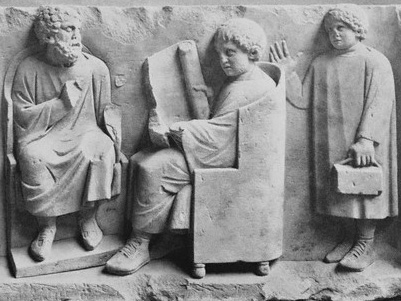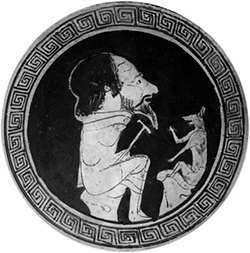Quiz Response Prompts
2-Feb Class
Because we're going to be doing very specific things in class, let's make this entry more free form. Please, then, in your journal entries, offer suggestions as to what could use discussion because:
- Confusing (I'm expecting plenty of that)
- Interesting (I'm hoping for some of that)
- Odd (I'd be surprised if there weren't any of that)
Or is there something else you want to address?
7-Feb Class
About 300 words of rhetorical re-elaboration, aka, auxēsis or exergasia, a rhetorical remix with your own particular stamp (see below) of "The Frog Who Isn't Talking to You."
- Please note that we'e looking not for a summary (a psilos logos) of the frog-phone fable, but for a 300-word re-elaboration of the summary (skeleton, psilos logos) we've already got. Does it have to be frogs and phones? No, not really. It does, though, have to connect recognizably with the essential elements of the original tale. But frogginess isn't essential.
For ideas, use:
- The following bare-bones narrative (psilos logos) and moral (epimuthion), worked out in class:
- "There was a frog, always on her phone, who was rude to everyone. But when she needed someone, no one was there for her. She died. Moral: Nothing is so important on your phone that you can be rude to others." (Only 206 characters, with spaces and moral — a tweet!) Does it have to be frogs and so on? No, I'd say that it doesn't matter whether it's the same cast of characters, setting (Seattle, it looks like), etc. So yes, kind of a creative project ... within limits.
- This Study Guide.
- The Theon, Pseudo-Hermogenes, and Burton readings (links below).
- The 2-Feb PowerPoint.
- The Progumnasmata page.

Assigned Readings
- This Study Guide
- Pseudo-Hermogenes, Progymnasmata ("exercises," trans. Kennedy). Pages 74-75 (on fable)
- Theon, Progymnasmata (also trans. Kennedy). Pages 71-72 (on elaboration and contradiction)
- On Burton's Silva Rhetoricae site, read entries on
Overall Aims
The aim is to prepare for the first set of oral presentations, which will take the form of fables, which in our period were a popular form of progumnasma, or "preliminary rhetorical exercise" (pro"before," gumnasma"exercise," as in "gymnasium").

Fable (muthos) as progumnasma. Think of this less as children's lit, more as a really focused exploration of persuasive discourse, pro and con (because you'll be contradicting your fables), and with rhetorical elaboration-augmentation of narrative.
It will be crucial to read carefully these readings (all of them) as they will form the basis of exercises (described below) in class.
Plan for 2, 7 Feb Classes (combined)
- Discussion of quiz responses.
- Lecture. I may need to fill in a few more things about texts (especially Theon's) and their significance/point.
- Fable work. This will be quick and dirty group work following the same steps as for the first installment of oral presentations. For this we'll:
- Be presented with a short fable ("The Frog Who Isn't Talking to You") that we'll all be working from.
- Take that story and boil it down to its barest, un-rhetoricized basics, though without losing essential features (the psilos logos).
- "Recompile" that into a brief but rhetorically more elaborate version, as per Theon, Pseudo-Hermogenes, Burton, and the Progumnasmata page.
- Contradict it. Tell the same story, but in a way that compellingly argues a moral contrary to the moral originally argued for, as per readings and lecture.

Muthos (fable)
In ancient Greek, the word muthos could mean many things. One of them was "myth," but that's not the meaning that concerns us here. Rather, we're concerned with muthos (aka logos) as "fable," defined as a "short story devised to convey some useful lesson" (OED), as in Aesop's Fables. Fables are always fictional and often involve animals. Key to fables are the lessons they teach, what we call the "moral," what ancient Greek writers call the epimuthion or epilogos, the "conclusion." Theon (see below) defines "fable" (muthos) as "a fictitious story giving an image of truth" (page 23). Dithmar, in Brill's New Pauly, writes, "The effective fable is predicated upon its ending, and aims toward a pointed conclusion."

Why fables? They're short and relatively uncomplicated, but very focused on issues of messaging: not simply how to express information in language, but how to shape reception of both message and messenger. As such, they're useful for teaching rhetoric.
Authors: Theon, Pseudo-Hermogenes
The Theon reading comes from a chapter in George Kennedy's book, Progymnasmata: Greek Textbooks of Prose Composition and Rhetoric, a collection of ancient Greek rhetorical textbooks/commentaries on textbooks in English translation. For the details of Theon's time and milieu, see Kennedy's introduction; suffice it here to say that Theon seems to have been active in the first century CE, toward the beginning of the second sophistic, and in a place, Alexandria in Egypt, already with a long history of cultural eminence in the Mediterranean.

The "pseudo-" is Pseudo-Hermogenes means, as you may have guessed, that the treatise in question is falsely attributed to real Hermogenes. In fact, we don't know who wrote it. We're also unsure of its date, though it probably dates to the second or third century CE.
Rhetorical Aspects
Theon's and Pseudo-Hermogenes' Exercises (as Kennedy calls them) address the teaching of a number of smaller-scale prose genres: chreiae (brief anecdotes containing a nugget of wisdom or wit), fables, and other genres, like encomium (praise) and ekphrasis (description). For now, though, we're concerned only with muthos, "fable." As already noted, this isn't about how to tell a cute story with animals to children. It's about how to dress up the briefest of bare-bones narratives (the psilos logos) with with pleasing and appropriately impactful narrative and language. But it's also about how to structure arguments and how to counter those arguments — how to perform well at speaking both pro and contra. It is, in other words, a suitable early step on the road to rhetorical mastery.
Pseudo-Hermogenes is more useful to us on fable than is Theon, whereas Theon's discussion of elaboration (exergasia) or auxēsis (augmentation), the process of fleshing out a bare-bones narrative with descriptive detail, direct-quotation dialogue, and other features, is worth reading. Those features include characterization (ēthopoiia) and personification (prosopopoiia), which in Theon (and elsewhere) can be rather hard to tell apart; taken together, they concern bringing dramatized characters to life, and endowing things or animals with human characteristics, notably, using directly quoted speech that is "in character."
Also useful is Theon on contradiction (antirrhēsis), the art of finding holes to poke in an argument, of turning a writer's or speaker's words against themselves — of turning them upside down — so as to create a counter-fable, one that aims to neutralize the argument that the original fable sought to make. In a way, that's what this is really about.
For help with some of these techniques, we're also using Gideon O. Burton's Silva Rhetoricae site.